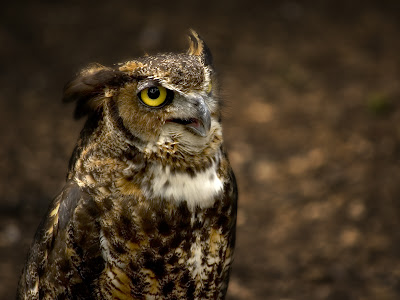 |
| The Blakiston's Fish Owl |
Flaying Animal | The Blakiston's Fish Owl | Massive owl with long, broad, horizontal ear-tufts. Pale grey-brown facial disc. Buff-brown, broadly streaked upperparts. Buff and dark brown barred wings. Pale tail with dark bars. White throat. Pale buffish-brown underparts with long streaks. Orange-yellow iris. Blakiston's Fish Owl, Bubo blakistoni, is a fish owl, a sub-group of eagle owls who specialized in hunting riparian areas. This species is a part of the family known as typical owls, Strigidae, which contains most species of owl. Surveys suggest that the fish owl population in the southern Russian Far East (encompassing all of Primorsky Krai and Khabarovsky Krai south from the Amur River) is approximately 100-130 pairs. With extrapolation to the entire fish owl range, the population could be more than 800 pairs. Recent surveys estimate one pair of Blakiston's fish owls every 3.8 river km along the Samarga River in northern Primorye, possibly the highest natural concentration of this species globally. Concentrations of breeding pairs in suitable habitat are generally described as one pair every 6-12 river km.
ReproductionBlakiston's fish owls can form pair bonds as early as their second year, and reach sexual maturity by age 3. Pairs do not breed every year. Courtship occurs from January-February, with a clutch of one or two eggs laid in March. Young fledge up to 50 days post-hatching. Data on breeding success are scant: on Kunashir Island during a 6-year period breeding success was 24%; with six fledglings resulting from 25 eggs. Juveniles remain on their natal territory into their second year, apparently dispersing as late as July the following year.
 |
| The Blakiston's Fish Owl |
Breeding and Status
This bird does not breed every year due to fluctuations in food supply and conditions. Laying of eggs begins as early as mid-March, when ground and trees are still covered with snow. These owls prefer nesting in hollow tree cavities in Japan (Takenaka 1998) and Russia (Slaght and Sumrach 2008). Reports of nesting on fallen tree trunks and on the forest floor are very rare occurrences at best, but possibly untrue. Other than nest cavities, there are very isolated records of nesting on cliff shelves and in old black kite nests (Takenaka 1998, Yamamoto 1999). Nest cavities have to be quite large in order to accommodate these birds. Clutch size is 1 to 3, usually 2 (Yamamoto 1999). In Russia, clutches are usually just one egg (Slaght and Surmach 2008). Eggs are 6.2 cm (2.5 in) long and 4.9 cm (1.9 in) wide. The males provide food for the incubating female and later the nestlings. The incubation period is about 35 days and young leave the nest within 35–40 days but are often fed and cared for by their parents for several more months.
 |
| The Blakiston's Fish Owl |
 |
| The Blakiston's Fish Owl |
Importance in Indigenous Cultures
Blakiston's fish owl is revered by the Ainu peoples of Hokkaido, Japan as a Kamuy (divine being) called Kotan koru Kamuy (God that Protects the Village). In Russia, the species is currently considered a food source by the Evens people in northern Siberia and the northern Russian Far East.
Blakiston's fish owl is revered by the Ainu peoples of Hokkaido, Japan as a Kamuy (divine being) called Kotan koru Kamuy (God that Protects the Village). In Russia, the species is currently considered a food source by the Evens people in northern Siberia and the northern Russian Far East.
 |
| The Blakiston's Fish Owl |
 |
| The Blakiston's Fish Owl |
Prey
The fish owl prey base is quite diverse, but even in winter, small fish are a primary target. In addition to fish, Blakiston's fish owls also prey on a variety of waterfowl species, small mammals, and amphibians. Reliance on certain prey species is seasonal: for example, in spring, frogs are particularly important and taken in great abundance.
The fish owl prey base is quite diverse, but even in winter, small fish are a primary target. In addition to fish, Blakiston's fish owls also prey on a variety of waterfowl species, small mammals, and amphibians. Reliance on certain prey species is seasonal: for example, in spring, frogs are particularly important and taken in great abundance.
 |
| The Blakiston's Fish Owl |











































